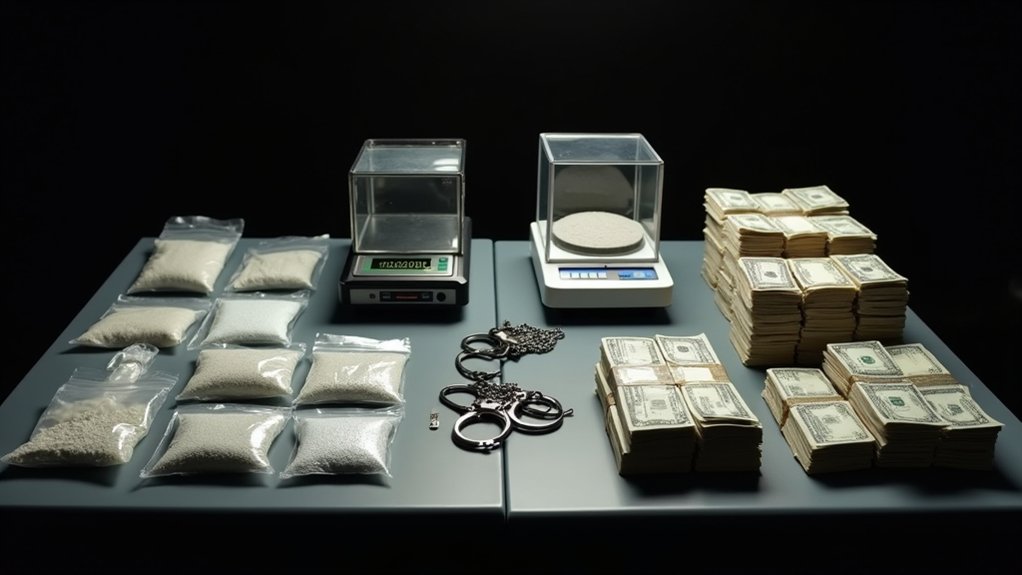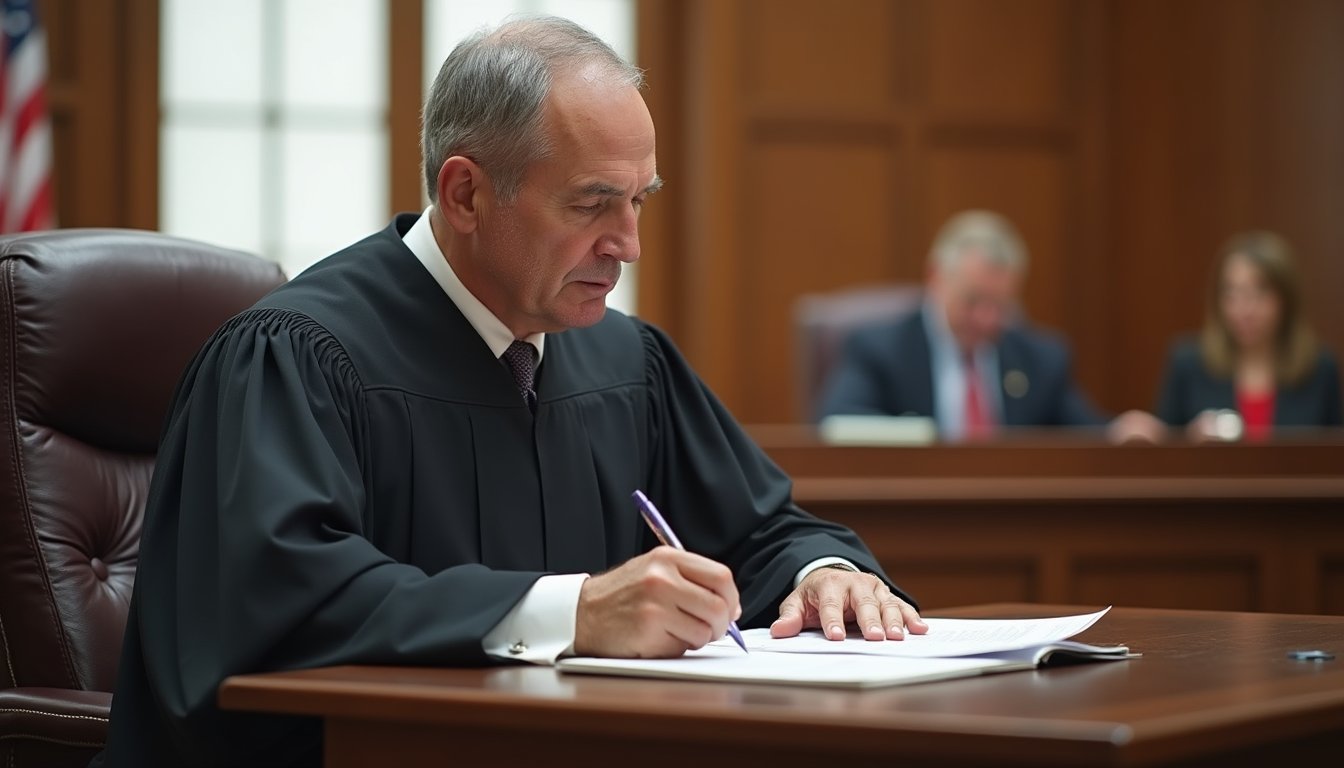Felony drug possession occurs when you’re caught with controlled substances exceeding legal thresholds, typically involving Schedule I or II drugs in quantities suggesting distribution intent. You’ll face severe penalties, including potential imprisonment from 4 years to life, substantial fines, and lasting criminal records. Your specific charges depend on drug type, amount, and prior convictions. Jurisdictional nuances can greatly impact your legal exposure, making strategic understanding vital for maneuvering these complex legal landscapes.
Understanding Drug Possession Legal Classifications

While traversing the complex landscape of drug possession laws, you’ll find that controlled substances are categorized into five distinct legal schedules that fundamentally determine the severity of potential criminal charges. These schedules rank substances based on their abuse potential and medical utility, with Schedule I drugs representing the most restrictive classification, lacking accepted medical applications like heroin and LSD. Prescription requirements play a pivotal role in distinguishing legal from illegal possession, particularly for Schedule II-V substances. Medical marijuana usage further complicates these classifications, as state laws may diverge from federal schedules. Comprehending these nuanced legal frameworks is paramount, as the specific schedule of a controlled substance directly influences potential penalties, ranging from misdemeanor to felony charges, depending on quantity, intent, and jurisdictional regulations. Controlled Substance Act establishes a comprehensive framework for classifying drugs, providing law enforcement and judicial systems with clear guidelines for prosecution and sentencing. Wordfence security tools can also help law enforcement and legal professionals manage access to sensitive information related to drug possession laws. Notably, California’s rehabilitation approach emphasizes treatment and diversion programs for nonviolent drug offenders, recognizing the complex social and personal factors contributing to substance abuse.
Criminal Threshold Definitions for Drug Offenses
When traversing drug possession legal landscapes, you must understand that criminal thresholds define the critical boundary between misdemeanor and felony charges. Your precise knowledge of specific quantity limits, whether federal or state, determines the severity of potential legal consequences, with possession above these thresholds automatically escalating to trafficking offenses. By recognizing these strategic demarcations, you can comprehend how drug amount, rather than intent, becomes the pivotal factor in criminal classification and sentencing. For instance, specific drugs like cocaine and methamphetamine have precise threshold amounts that legally transform possession into a more serious trafficking charge. Federal mandatory minimum sentencing guidelines underscore the critical legal boundaries for drug quantities, where exceeding specific weight thresholds can trigger severe prison terms ranging from 5 to life imprisonment. Nevada’s legal framework specifically categorizes drug offenses with escalating penalty tiers based on the quantity and type of controlled substance seized during arrest.
Drug Amount Classifications
Because drug possession laws hinge critically on quantity thresholds, criminal classifications for drug offenses depend on precise measurements that trigger escalating legal consequences. Your understanding of weight determination factors and analytical laboratory testing becomes pivotal in maneuvering these legal definitions.
Federal and state statutes categorize drug quantities through intricate measurement protocols, examining total mixture weight, substance purity, and detectable drug amounts. You’ll find that thresholds vary dramatically between jurisdictions, with specific gram or weight cutoffs distinguishing misdemeanor from felony charges. Schedule classifications compound these assessments, with Schedule I and II substances facing more stringent quantity calculations.
Sophisticated forensic evaluations determine exact drug quantities, directly impacting potential sentencing and criminal prosecution strategies.
Legal Possession Boundaries
Criminal drug possession laws delineate precise legal boundaries that transform seemingly ordinary actions into potentially serious criminal offenses. You’ll need to understand that possession isn’t merely physical holding, but encompasses knowing dominion and control over controlled substances. Whether the drug is on your person, within reachable distance, or under your indirect control, legal thresholds apply rigorously. Controlled substance detection through advanced forensic techniques can reveal trace amounts that could trigger legal prosecution even in minimal quantities.
Cannabis possession limits vary by jurisdiction, with California permitting up to 28.5 grams for adults. However, repeat offender penalties can dramatically escalate charges from misdemeanors to felonies. Your legal exposure increases with factors like proximity to protected zones, possession of paraphernalia, or concurrent criminal activities. Constructive possession means you can be charged even without direct physical contact, making understanding these boundaries critical for avoiding severe legal consequences. Possession intent factors can significantly influence whether you’re charged with a misdemeanor or felony, including the quantity of drugs, packaging methods, and surrounding circumstances. Moreover, drug schedule classification directly impacts the severity of potential criminal charges, with higher-risk substances triggering more stringent legal penalties.
Criminal Intent Criteria
How do prosecutors transform a mere drug possession charge into a serious felony? They strategically establish presumed criminal intent by analyzing the defendant’s knowledge level and surrounding circumstances. Large drug quantities, possession of distribution paraphernalia, and specific location contexts become critical evidence demonstrating intent beyond personal consumption.
Criminal intent isn’t uniform; it ranges from specific intent (deliberate distribution plans) to general intent (knowingly possessing controlled substances). Prosecutors must prove beyond reasonable doubt that the defendant’s mental state transcends simple possession. Statutory thresholds and controlled substance classifications further amplify potential charges, with intent elevating misdemeanors to felonies. The government’s rigorous approach to substance control emphasizes the seriousness of maintaining strict regulations over drug distribution.
The defendant’s actions, circumstantial evidence, and mental state become pivotal in determining the severity of drug possession charges, making intent a sophisticated legal determination. Fundamentally, drug paraphernalia evidence like scales and packaging materials can decisively signal the prosecution’s narrative of intentional distribution beyond personal use. Under federal conspiracy laws, mandatory minimum sentences can significantly increase the potential penalties for drug-related offenses, underscoring the legal system’s commitment to deterring drug distribution.
Types of Drug Possession: Actual and Constructive
When traversing the legal landscape of drug possession charges, understanding the nuanced distinctions between actual and constructive possession becomes critical for defendants and legal professionals. State drug possession statutes can significantly impact how these legal definitions are interpreted and applied. Fingerprint evidence can further complicate the determination of possession, linking a defendant to a controlled substance even without direct physical contact. Drug paraphernalia often serves as additional evidence in establishing possession beyond the controlled substance itself.
Key distinctions include:
- Actual possession requires direct physical control with explicit knowledge of the substance’s illegal nature.
- Constructive possession involves control over an area where drugs are located, even without immediate physical contact.
- Constructive possession rebuttals often challenge case law precedents by demonstrating lack of knowledge or control.
Prosecutors must strategically establish evidence linking the defendant to the controlled substance. While actual possession presents more straightforward legal arguments, constructive possession demands sophisticated evidentiary standards. Courts examine circumstantial evidence, including proximity, access, and potential shared control, to determine criminal liability in these complex drug possession scenarios.
Differentiating Misdemeanor and Felony Charges

After examining the nuanced legal dynamics of drug possession types, understanding the categorical distinctions between misdemeanor and felony charges becomes paramount for extensive legal comprehension. You’ll find that mitigating factors like substance quantity, drug schedule, and intent critically differentiate these charges. Misdemeanors typically involve smaller drug amounts and less dangerous substances, while felonies encompass larger quantities, distribution evidence, and Schedule I/II controlled substances. Your potential legal exposure escalates when aggravating factors emerge, such as possession in drug-free zones or prior criminal history. Felony classifications carry severe collateral damage, including prolonged imprisonment, substantial fines, and lasting criminal records that can permanently impact professional and personal opportunities. Understanding these distinctions becomes critical for traversing potential legal consequences. Felony drug manufacturing represents a significant escalation in criminal liability, often involving the production of controlled substances like methamphetamine or large-scale marijuana cultivation.
Statutory Penalties and Sentencing Guidelines
When confronting felony drug possession charges, you’ll face a complex landscape of statutory penalties ranging from 4 to life imprisonment, with fine structures directly tied to drug type, quantity, and specific offense characteristics. Your potential sentence hinges on critical factors including the drug classification, volume of controlled substances, prior criminal history, and specific circumstances surrounding the arrest. Understanding these nuanced sentencing guidelines is pivotal, as they can dramatically impact the legal consequences you may encounter, with penalties escalating swiftly based on aggravating elements like prior convictions, offense location, and potential harm caused.
Prison Term Ranges
Drug possession prison terms reflect a complex legal landscape where statutory penalties and sentencing guidelines intersect to determine an individual’s potential incarceration. Your understanding of prison term ranges requires strategic analysis across multiple dimensions:
- Federal charges typically carry longer sentences (averaging 81 months) compared to state-level penalties, with mandatory minimums substantially impacting potential imprisonment.
- Judicial discretion allows judges to examine mitigating factors, potentially modifying sentencing alternatives based on specific case circumstances.
- Drug classification, quantity, and prior convictions critically influence the final prison term, with some offenses potentially resulting in life imprisonment.
Navigating these legal frameworks demands precision. Felony drug possession penalties vary extensively, reflecting the nuanced approach of both federal and state legal systems in addressing drug-related criminal activities.
Fine Calculation Factors
Traversing the intricate landscape of felony drug possession fines calls for a strategic understanding of complex legal mechanisms. You’ll encounter nuanced calculations driven by drug type, quantity, and federal sentencing guidelines. The base fine depends on your specific offense, with Schedule I and II substances triggering higher penalties.
Your judicial discretion plays a critical role in fine determination, considering factors like prior convictions, intent to distribute, and ability to pay. Quantity thresholds greatly influence base offense levels, while aggravating circumstances can dramatically escalate financial penalties. Asset forfeiture laws may impose additional monetary consequences beyond statutory fines.
Courts assess your individual case thoroughly, balancing punitive measures with proportional financial sanctions tailored to the specific drug possession circumstances.
Impact of Prior Convictions on Drug Possession Charges

How substantially can prior drug convictions reshape your legal landscape? Your criminal history can dramatically alter your defense options and plea bargaining opportunities, creating a complex legal terrain:
- Sentencing Escalation: Repeat offenses trigger statutory enhancements, potentially doubling mandatory minimums or elevating charges to more severe classifications.
- Prosecutorial Leverage: Prosecutors gain significant discretion, often pursuing aggressive charging strategies based on your documented history of drug-related infractions.
- Judicial Scrutiny: Courts become less sympathetic, viewing subsequent offenses as patterns of behavior rather than isolated incidents.
Each prior conviction narrows your legal strategies, limiting alternative sentencing, rehabilitation programs, and plea negotiations. Judges and prosecutors will prioritize public safety concerns, interpreting your criminal record as an indicator of increased risk and potential recidivism.
Mandatory Minimum Sentencing Structures
When prior drug convictions narrow legal pathways, mandatory minimum sentencing structures emerge as the next critical legal mechanism constraining individual judicial discretion. You’ll encounter specific thresholds for controlled substances that trigger substantial prison terms: 100 grams of heroin, 500 grams of cocaine, or 5 grams of methamphetamine can initiate five-year mandatory minimums. Sentencing guideline application becomes pivotal in traversing these stringent frameworks, where plea bargaining strategies can potentially mitigate severe penalties. Your legal strategy must account for substance type, quantity, and potential enhancements like serious bodily injury or death, which can escalate mandatory minimums to twenty years or even life imprisonment. Understanding these precise statutory parameters is essential for thorough legal defense in federal drug prosecution scenarios.
Long-term Personal and Professional Consequences
Inevitably, felony drug possession casts a profound shadow over an individual’s personal and professional trajectory, systematically eroding opportunities across multiple life domains. Your future becomes constrained by multifaceted legal and social barriers:
- Employment prospects drastically diminish, with widespread discrimination blocking career advancement and professional licensing.
- Family reunification challenges emerge, where parental rights may be restricted and social stigma complicates interpersonal relationships.
- Community reintegration barriers manifest through limited housing access, voting disenfranchisement, and restricted social welfare benefits.
The cumulative impact transcends individual experience, generating systemic economic disadvantages. Your felony drug possession record becomes a persistent obstacle, undermining potential for rehabilitation and sustainable socioeconomic recovery. Each restriction strategically compounds the initial legal consequence, creating a complex ecosystem of long-term marginalization that extends far beyond the original judicial intervention.
Variations in State and Federal Drug Possession Laws
Although drug possession laws might seem uniform across the United States, the legal landscape is remarkably complex and stratified between state and federal jurisdictions. You’ll encounter significant variations in how possession offenses are prosecuted, with state laws offering more nuanced approaches to parole eligibility and diversion programs compared to federal statutes. Federal prosecutors typically target large-scale operations and interstate trafficking, while state courts focus on individual possession cases. Your potential penalties depend on jurisdiction, drug type, quantity, and prior criminal history. Some states provide alternative sentencing options for first-time offenders, whereas federal mandatory minimums restrict judicial discretion. Understanding these jurisdictional differences is essential when maneuvering drug possession legal challenges, as the consequences can dramatically impact your future legal and personal standing.
Frequently Asked Questions
Can Someone Be Charged With Possession if Drugs Are Found in Their Car?
Yes, you can be charged with drug possession if substances are found in your car through vehicle search policies. Under constructive possession laws, all occupants may face charges if drugs are present, even if they’re not physically holding them. You’ll be presumed to know about and control the drugs unless you can prove otherwise, such as demonstrating lack of knowledge or exclusive control by another passenger.
What Happens if Prescription Medication Is Not in the Original Bottle?
You’ll face potential legal risks if your prescription medication isn’t in its original bottle. Unsecured storage can constitute improper prescribing evidence, potentially leading to charges of illegal possession. Law enforcement may interpret this as tampering or intent to distribute. Even with a valid prescription, you’re legally required to maintain medication in labeled containers. Carry your prescription documentation to mitigate potential legal complications.
Do First-Time Offenders Always Receive Mandatory Jail Time for Drug Possession?
No, you won’t automatically receive mandatory jail time for first-time drug possession. Most states and federal systems offer probation alternatives and rehabilitation programs for personal-use quantities. Your specific outcome depends on factors like substance type, amount, jurisdiction, and criminal history. Judges often have discretion to impose diversion, treatment, or probation instead of incarceration, especially for nonviolent, first-time offenders with small quantities.
How Can a Drug Possession Charge Affect Future Job Opportunities?
A drug possession charge can severely limit your employment prospects by creating long-term criminal record implications. You’ll face reduced callback rates, potentially decreased lifetime earnings, and increased workplace discrimination. Employers may automatically screen you out of customer service, office, and professional roles. Your conviction can trigger systemic barriers that restrict job opportunities, making career advancement challenging and potentially relegating you to lower-wage, less stable employment sectors.
Is It Possible to Get a Felony Drug Charge Expunged From Record?
You can get a felony drug charge expunged, but you’ll need to meet specific expungement eligibility requirements. First, reduce the felony to a misdemeanor through a strategic legal process. Then, file a precise petition demonstrating you’ve completed probation, met all court conditions, and haven’t committed new offenses. The expungement process varies by case complexity, so consulting a legal professional can optimize your chances of successful record clearance.

